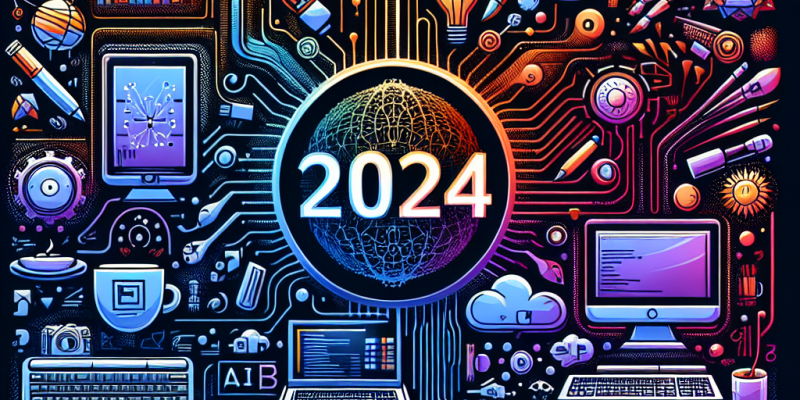Artificial Intelligence and Its Impact on Creative Industries in 2024

As we step into 2024, the role of Artificial Intelligence (AI) in creative industries has reached a new level of sophistication and integration. From film and music to fashion and literature, AI is no longer just a tool; it has become a collaborator, changing the landscape of creativity in profound ways. This article examines the multifaceted impact of AI on creative industries in 2024, focusing on its transformative capabilities, ethical implications, and future prospects.
Enhanced Creative Processes
In 2024, AI technologies have evolved significantly, allowing creators to harness vast datasets for inspiration and innovation. For instance, AI algorithms can analyze hundreds of thousands of songs, films, or artworks to identify trends, styles, and narrative structures. By sifting through this data, artists can discover new creative pathways and push the boundaries of their disciplines.
Music Production: AI-powered tools like OpenAI’s MuseNet and Amper Music are enabling musicians to compose original pieces by simply inputting mood, genre, or instrumentation preferences. In 2024, platforms have become even more sophisticated, enabling real-time collaboration between human artists and AI, resulting in unique fusions of sound that reflect diverse cultural influences.
Film and Animation: In the film industry, AI-driven software can assist in scriptwriting, storyboarding, and even video editing. AI has not only streamlined production processes but also enabled filmmakers to experiment with narrative possibilities. Advanced algorithms analyze audience preferences and historical performance data to predict the likely success of various plot twists or endings, guiding filmmakers in crafting compelling stories.
Fashion Design: Fashion houses are now utilizing AI to predict trends and analyze consumer behavior, significantly influencing design processes. Algorithms that analyze social media feeds, street style, and runway shows allow designers to create collections that resonate with current tastes. In 2024, AI-assisted pattern generation and textile design are commonplace, allowing for innovative and sustainable fashion solutions.
Democratizing Creativity
One of the most exciting aspects of AI in 2024 is its potential to democratize the creative process. Previously, access to professional-grade creative tools was limited to those with the resources or training. However, AI-powered applications are making these tools more accessible to everyone, leading to an explosion of creativity across demographics and skill levels.
Platforms like DALL-E and Midjourney have allowed both amateur and professional artists to generate high-quality visuals with simple prompts, blurring the lines between professional art and hobbyist creation. This democratization fosters a more inclusive creative landscape, where diverse voices can emerge and thrive. The rise of AI-generated content has also led to new art movements that challenge traditional definitions of authorship and creativity.
Ethical Considerations
Despite its many benefits, the integration of AI into creative industries raises several ethical concerns that require careful consideration. Questions around copyright and ownership have taken center stage in discussions about AI-generated content. As AI becomes more capable of producing art, music, and literature, issues about who owns the rights to these works are increasingly complex.
In 2024, creators and legal systems are actively navigating these challenges, emphasizing the need for new frameworks to address intellectual property rights in an AI-driven world. Additionally, the potential for AI to perpetuate biases present in training data raises alarms about the authenticity and inclusivity of AI-generated works. As the technology continues to evolve, ongoing scrutiny and ethical guidelines will be essential to ensure the integrity of creative industries.
The Future of AI in Creative Industries
Looking ahead, the collaboration between AI and human creators is likely to deepen. With continual advancements in machine learning and natural language processing, we can expect to see tools that are not only more intuitive but also capable of understanding context, emotions, and cultural nuances. Future iterations of AI could potentially assist in creating entirely new genres of art, music, and literature that we can only imagine today.
Moreover, the role of AI in enhancing immersive experiences in virtual and augmented reality will redefine storytelling and engagement in creative industries. Consumers may find themselves not just passive observers of art and media but active participants in co-creating experiences, blurring the lines between audience and creator.
Conclusion
As we delve deeper into 2024, the impact of AI on creative industries is unmistakable. It has transformed the creative process, democratized access to creation, and introduced a myriad of ethical questions that society must address. While challenges remain, the potential for human-AI collaboration opens up exciting possibilities for innovation and expression. As creators and technologists continue to explore this uncharted territory, one thing is certain: the future of creativity is intertwined with the advancements of artificial intelligence, marking an era of unprecedented artistic exploration and evolution.














